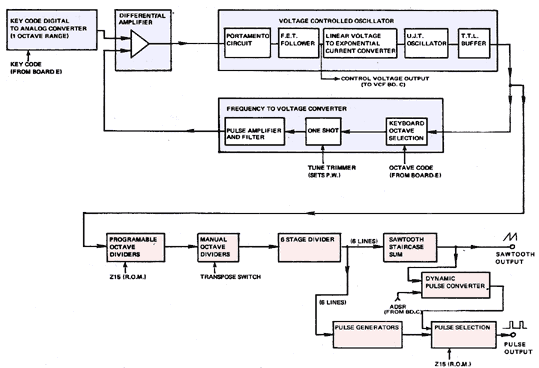The second mysterious ARP Avatar patent. Why is ARP not the
assignee? Maybe to hide the patent from competitors? (It
was sure hidden from me until "Mike I" clued me in!) The
content of Leroy Young's patent, above, is included within this
patent, yet there's no credit mentioned. One can only imagine
the drama at the time.
The Avatar was a monophonic synthesizer, but it used a hex pickup to
provide signals from the individual guitar strings and the hex
circuitry in the pitch extractor allowed for a more precise analysis
of the signal for the case where the guitarist plays a string while
the previous note on a different string is still decaying.
From the hex pickup, the signals for each string go through a preamp
and a trigger generator circuit that finds note
transients. From the trigger signals, a priority encoder chip
and a latch find the most recently played string, and a multiplexer
selects only that string's signal to go through the rest of the
pitch detection circuitry.
This patent assumes a hex pickup providing signals for the
individual guitar strings, though the pickup itself is not
included. The Roland guitar synthesizer patent (US 4,357,852)
was filed 5 months after this one and it does include the hex
pickup.
The signal is compressed (to adapt to various playing styles), and
filtered (to remove content outside the range we're interested in)
and turned into a square wave with some level detectors. There
is some timing circuitry to assure that a full cycle has been found
before the pitch conversion process really starts.
Leroy Young's circuit is used to measure the period of input
frequency, store that in a register, and use that to set a
divide-by-N counter.
In addition there's a 40-bit-long-12-bit-wide shift register build
with a pair of Signetics 2519's. (Wow, how often do you see
something like that!). The period measurement is applied to
the shift register, some logic clocks the shift register at 250 kHz
during the first 50 mSec after the note starts, and at 1.0 kHz after
that. That's a delay of 0.16 mS at the beginning of the note
while the shift register is being filled up, and 40 mSec delay for
the rest of the time. So as the note dies out we still have a
sample of the period from 40 mSec before. This is intended to
keep the pitch from sagging as the input waveform decays.
Finally, a phase-locked loop (PLL) tracks the frequency and provides
a voltage output that follows the guitar note. The PLL
described here closely resembles the CD4046 with its edge-triggered
phase detector.
This patent mostly matches the schematics in the Avatar Service
Manual. The guitar signal processing circuitry of Figure 1 of
the patent and the PLL circuitry of Figure 3 are encapsulated
modules in the Avatar and their schematics are not included in the
Service Manual. The Avatar also includes a "hex fuzz" circuit
which is not mentioned in the patent.
The patent drawings are a little sloppy; a transistor is missing its
emitter arrow, some reference designators are used multiple times, a
number of components don't have reference designators, some
terminals are left unconnected, one of the diodes in the PLL circuit
is backwards. Some of the opamps in the schematics are really
open-collector comparators but that's not mentioned in the text so
the circuit and its description make no sense at all. No parts
values are given, but I'm guessing that's just to make it more
difficult for any competition.
References:
- ARP Avatar Service Manual,
ARP Instruments, Inc., January 1978
![[patent thumbnail]](images/US03230468.gif)
![[patent thumbnail]](images/US03320530.gif)
![[patent thumbnail]](images/US03329836.gif)
![[patent thumbnail]](images/US03369128.gif)
![[patent thumbnail]](images/US03444362.gif)
![[patent thumbnail]](images/US03665089.gif)
![[patent thumbnail]](images/US03715444.gif)
![[patent thumbnail]](images/US03784935.gif)
![[patent thumbnail]](images/US03805091.gif)
![[patent thumbnail]](images/US03924199.gif)
![[patent thumbnail]](images/US04011466.gif)
![[patent thumbnail]](images/US03828110.gif)
![[patent thumbnail]](images/US04136595.gif)
![[patent thumbnail]](images/US03930429.gif)

![[patent thumbnail]](images/US03965789.gif)
![[patent thumbnail]](images/US04144790.gif)
![[patent thumbnail]](images/US04217803.gif)
![[patent thumbnail]](images/US04257305.gif)
![[patent thumbnail]](images/US03851265.gif)
![[patent thumbnail]](images/US04300431.gif)